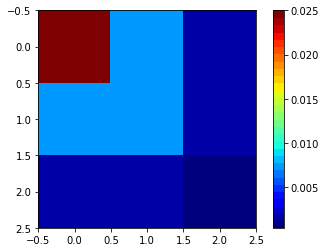Covariance and Correlation Coefficient
Covariance
서로 다른 populations으로 부터 가져온 samples을 비교할때, 가장 많이 사용되는 방법이 covariance와 correlation입니다.
Sample covariance의 공식은 다음과 같습니다.
Code Examples
def covariance(data, data2=None, ddof=0):
k = data.shape[0]
N = data.shape[1]
if data2 is not None:
k += data2.shape[0]
data = np.vstack((data, data2))
cov = np.zeros((k, k))
for i in range(k):
for j in range(k):
a = data[i]
b = data[j]
cov[i, j] = np.sum((a-np.mean(a)) * (b-np.mean(b)))/(N-ddof)
return np.array(cov)
data = np.array([[4.0, 4.2, 3.9, 4.3, 4.1],
[2.0, 2.1, 2.0, 2.1, 2.2],
[0.6, 0.59, 0.58, 0.62, 0.63]])
print('[Numpy Covariance]')
print(np.cov(data))
print()
print('[My Covariance]')
print(covariance(data, ddof=1))
cax = imshow(np.cov(data), interpolation='nearest', cmap=cm.get_cmap('jet', 30))
colorbar(cax)결과값
[Numpy Covariance]
[[ 0.025 0.0075 0.00175]
[ 0.0075 0.007 0.00135]
[ 0.00175 0.00135 0.00043]]
[My Covariance]
[[ 0.025 0.0075 0.00175]
[ 0.0075 0.007 0.00135]
[ 0.00175 0.00135 0.00043]]
Problems with Interpretation
Covariance의 값이 크면 클수록 strong relationship을 나타냅니다.
하지만 서로 다른 수치를 갖은 값끼리 (원달러 vs 엔화, inches vs Km) 비교를 할 수는 없습니다.
해석의 가장 큰 문제점은 결과값의 range자체가 다양하기 때문에 해석의 어려움이 있습니다.
예를 들어서 데이터가 달라짐에 따라서 결과값이 3이 될수도 있고, 500000이 될 수도 있습니다.
300이라는 값이 두 variables사이의 관련성이 있다는 것을 설명할수는 있지만 correlation coefficient와는 다르게 정확하게 얼마나 강한 관계를 갖고 있는지는 설명을 못합니다.
Correlation Coefficient
위에서 적었듯이 covariance는 해석상의 문제가 있습니다. (즉 관련성 있는건 알겠는데 정확하게 얼마나 관련성이 있는지 확신하기 어려움..) 이를 해결하기 위해서는 Correlation coefficient를 사용하면 되면 아래와 같은 공식을 사용하면 되며 결과값의 range는 -1 그리고 1 사이의 값을 갖습니다.
def correlation_coefficient(data, data2=None, ddof=0):
k = data.shape[0]
N = data.shape[1]
if data2 is not None:
k += data2.shape[0]
data = np.vstack((data, data2))
cov = np.zeros((k, k))
for i in range(k):
for j in range(k):
a = data[i]
b = data[j]
cov[i, j] = np.sum((a-np.mean(a)) * (b-np.mean(b)))/(N-ddof)
cov[i, j] /= (np.std(a) * np.std(b))
return np.array(cov)
print('[Numpy Correlation Coefficient]')
print(np.corrcoef(data))
print()
print('[My Correlation Coefficient]')
print(correlation_coefficient(data))[Numpy Correlation Coefficient]
[[ 1. 0.56694671 0.533745 ]
[ 0.56694671 1. 0.77812706]
[ 0.533745 0.77812706 1. ]]
[My Correlation Coefficient]
[[ 1. 0.56694671 0.533745 ]
[ 0.56694671 1. 0.77812706]
[ 0.533745 0.77812706 1. ]]